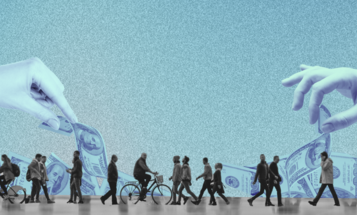
A Brief History of Public Goods
There's a dire need for a new definition of public goods
In a September PolicyShop post, “Why Aren’t We Talking About Public Goods?,” I argued that progressives need a new frame and a new vocabulary to counter the free-market, shrink-and-privatize-government rhetoric that dominates public and political discourse today. I suggested that the concept of “public goods” can provide that frame.
In this and my next two posts I discuss the dire need for a new, instrumental definition of public goods, one that can provide a sound conceptual foundation for improved governance and a better-functioning democracy. I will propose such a definition in a later post. Before that, I will give a thumbnail review of the evolution of the mainstream economic definition and show why it is essentially useless, particularly for public policy purposes.
Audacious goals, you may say. Yes, indeed. But we need to be bold.
Government has been under attack for four decades. Those who have led the most recent assault nearly succeeded this fall at imploding national government. Even now they are refilling their cannons. Although the American public proclaims itself sick of Washington “gridlock,” substantial numbers of them voted for the gridlockers.
“The 40-year assault on government is a clear case of mumpsimus (a view stubbornly held in spite of clear evidence that it’s wrong),” writes Bill Barnes in a recent issue of Public Administration Times.
Yet the radical Right continues to speak of the shutdown of government as a noble cause. A regular contributor to Forbes, John Tamny, sums up the crusade this way:
The Republican Party now has a brand that says it’s willing to stand athwart the obnoxious growth of Leviathan. Its decision to allow a shutdown of the federal government, and to ideally allow it to remain shut through the 2014 elections absent substantial concessions from the Democrats, is both good politics and economics.
But there is also good news. The shutdown brought the extent and value of government services to the attention of an ordinary public that is usually distracted by the demands of daily living. And the “civil war” now being fought between establishment Republicans and the radical Right offers an opening for a new, constructive message from progressives. The challenge is to find a better way to counteract the “dismantl[ing] of the fabric of the state” and to restore respect for the legitimacy of government and the public economy.
Public Goods – A Brief History
The widespread derogation of government and invalidation of the public economy emerge directly from the neoclassical economic theory that is taught in most colleges and universities. Such economics is also behind the thinking evident among our most powerful policy makers and “thought leaders” right, center, and left. Neoclassical economics lies, unseen, behind much of the rhetoric that shapes public policy nationally and across the country.
One of the least recognized examples of the largely unseen influence of neoclassical economic doctrines is the prevailing market-myopic definition of public goods.
While public goods – the goods and services produced by government – ground and secure the lives of citizens in all advanced democracies, virtually no one uses the term outside of economics classrooms and discussions.
Paul Samuelson’s sixty-year-old formulation, in which public goods are defined as “non-rivalrous” and “non-excludable,” prevails in economic textbooks and relegates public goods to “market failure”. In this market-fundamentalist world, public goods are routinely labeled “a problem.” And that’s what college students are taught.
Libertarians in particular, but also many mainstream neoclassical economists, view the market as the only legitimate source of goods and services production, and they work constantly – through the theories they advance in the academy and the policies they propagate via think tanks – to minimize the importance as well as the size of government. Grover Norquist’s call to “shrink government down to the size where we can drown it in the bathtub” didn’t come out of the blue. Shrinking government to a minimum size is fundamental to the neoclassical creed. And this view stems directly from the negative characterization of non-market-derived public goods.
Although the Real World Economics Association and the “post-autistic economics movement” are now challenging neoclassical economics, there are almost no heterodox or pluralist economists questioning Samuelson’s definition with its perniciously-negative characterization of the public economy and its destructive impacts on government and governance. Most academic theorists of public administration, political science, and political philosophy are neither expressing nor exposing the problem. Practitioners – government leaders, administrators, and managers – are unaware that what they are producing, simply put, are public goods.
It was not always thus.
The concept of public goods, and government provision thereof, had a vastly more positive connotation before Samuelson’s view took center stage in the 1950s.
Although Samuelson is credited with the current definition, Maxime Desmarais-Tremblay has shown how the ideas of “non-excludability” and “non-rivalry” were earlier developed (beginning in the 1930s) by Richard Musgrave, a fellow student with Samuelson at Harvard. Musgrave, however, had a far more positive conception of the idea of government provision of goods and services.
Musgrave’s contributions built upon the ideas of 19th-century European thinkers concerning the importance of the political process, which must “be substituted for the market mechanism” in determining the allocation of public goods. Putting the work of Musgrave and Samuelson in historical context, Sturn has thrown a spotlight on the extent to which “public goods” and the “public economy” took a beating from mid-20th century economists. Apparently aghast at the negative turn against the concept of a public economy, Musgrave said that he did not “wish to ‘leave the state as the defendant who must prove his innocence.’” He did not see the public sector “as a necessary evil whose optimal size is determined by the idea that it should be kept to a minimum.” Rather, according to Sturn, Musgrave insisted that public goods be “duly regarded as the conceptual basis for specific mechanisms of the public economy, entailing collective choices and the institution-based enforcement of their outcome.”
Samuelson, however, rejected any notion of a political process in his “pure” definition, which according to the dictates of mainstream economics, had to be made amenable to mathematical modeling (wonderfully dubbed “sterile mathematical recreation” by Stretton and Orchard). In 1983, Musgrave severely criticized Samuelson’s formulation as “somewhat of a scholastic exercise, of little help to improving the fiscal performance of the real world setting.” Unfortunately, all that generations of economics students have learned about public goods is Samuelson’s narrow, mathematically-tractable definition, with its devaluing of all things non-market.
Virtually no economics textbooks or literature mention Musgrave (per Tremblay). Nor is it easy to find any reference to the existence of the positive, affirmative concept of public goods that existed before Samuelson’s abstract, pejorative formulation took over. In most of the literature on public goods virtually no mention is made of Musgrave’s pioneering contributions to public goods theory nor his far more estimable view of the role of government in public goods provision. The absence of his presence has arguably helped shape the negative path that public economics theory has taken in the past four decades.
June Sekera is leading the Public Goods Initiative, a project to develop and advance a new concept of public goods that supports democracy and the public economy, and a non-market-based concept of production to support improved governance. [email protected].



